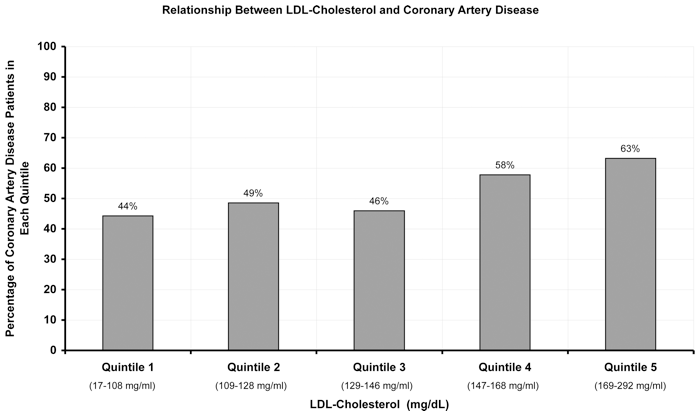One of the great marketing successes of the pharmaceutical industry has been the linkage between LDL cholesterol levels and heart disease. In essence, the message, “if your LDL cholesterol is high, you are going to die,” is powerful. Unfortunately, the data states otherwise.
It was known in the mid 1990s that oxidized LDL was the primary suspect in the development of atherosclerotic lesions; not natural, non-oxidized LDL. But it was also at this time that the first statin studies began to appear, and that gave the pharmaceutical industry a patented drug to “prevent” heart disease (2). It was such a good story to tell and an even better one to sell. Unfortunately, as I pointed out in an earlier blog, it has never held up well against unbiased scrutiny, especially in patients with high cholesterol levels but without any heart disease.
Part of the reason lies in the data. Shown below is the correlation of LDL cholesterol to heart disease

You can see from this data that there is a higher percentage of cardiovascular disease patients with high LDL cholesterol levels compared with very low levels, but not that much. This explains why about half the people who die from heart disease have normal LDL cholesterol levels (less than 130 mg/dl). It also means that high LDL cholesterol is not a very good predictor of heart disease.
On the other hand, a very different picture emerges if you look at the levels of oxidized LDL levels as shown below.

Even without a background in statistics you can see a very striking relationship in the prediction of heart disease with increasing levels of oxidized LDL levels.
So why don’t physicians use oxidized LDL levels as an indicator of heart disease risk? First, the test is much more difficult to do than a simple cholesterol test. Second, it ruins a great story that is easy to communicate to the patient. Third, the best way of reducing oxidized LDL levels is natural anti-oxidants, such as polyphenols, that have no patent protection (3,4). Reducing LDL cholesterol is simple. Just take a statin drug for the rest of your life. Reducing oxidized LDL cholesterol requires having plenty of antioxidants in your diet with polyphenols the most powerful.
Now there is another new entry into the LDL story. This is “super-sticky” LDL. In an online pre-publication, it was demonstrated that this new type of LDL particle may be even worse than oxidized cholesterol in promoting the development of heart disease (5). This “super-sticky” LDL comes from the formation of advanced glycosylation end products (AGEs). I described this formation of protein-carbohydrate linkages as an integral part of the aging process in my book, “The Anti-Aging Zone,” published more than a decade ago (6).
The best way to reduce the production of “super-sticky” LDL is to reduce blood sugar levels. This helps explain why individuals with diabetes are two to three times more likely to develop heart disease. The best way to reduce elevated blood sugar is the Zone diet. That’s why the latest dietary recommendations for the treatment of diabetes by the Joslin Diabetes Research Center at Harvard Medical School are essentially identical to the Zone diet.
Heart disease remains the number-one cause of death in America. Unfortunately, it is more complex than “taking a statin a day to keep death away”.
References:
- Maor I and Aviram M. “Oxidized low-density lipoprotein leads to macrophage accumulation of unesterified cholesterol as a result of lysosomal trapping of the lipoprotein hydrolyzed cholesterol ester.” J Lipid Res 35: 803-819 (1994).
- Simvastatin Study Group. “Randomized trial of cholesterol lowering in 4,444 patients with coronary heart disease: the Scandinavian Simvastatin Survival Study (4S).” Lancet 344: 1383-1389 (1994).
- Shafiee M, Carbonneau MA, Urban N, Descomps B, and Leger CL. “Grape and grape seed extract capacities at protecting LDL against oxidation generated by Cu2+, AAPH or SIN-1 and at decreasing superoxide THP-1 cell production.” Free Radic Res 37: 573-584 (2003) (ISSN: 1071-5762).
- Chen CY, Yi L, Jin X, Mi MT, Zhang T, Ling WH, and Yu B. “Delphinidin attenuates stress injury induced by oxidized low-density lipoprotein in human umbilical vein endothelial cells.” Chem Biol Interact 183: 105-112 (2010).
- Rabbani N, Godfrey L, Xue M, Shaheen F, Geoffrion M, Milne R, and Thornalley PJ. “Glycation of LDL by methylglyoxal increases arterial atherogenicity.” Diabetes 60 doi:10.2337/db09-1455 (2011).
- Sears B. “The Anti-Aging Zone.” Regan Press. New York, NY (1999).






Let Us Know What You Thought about this Post.
Put your Comment Below.